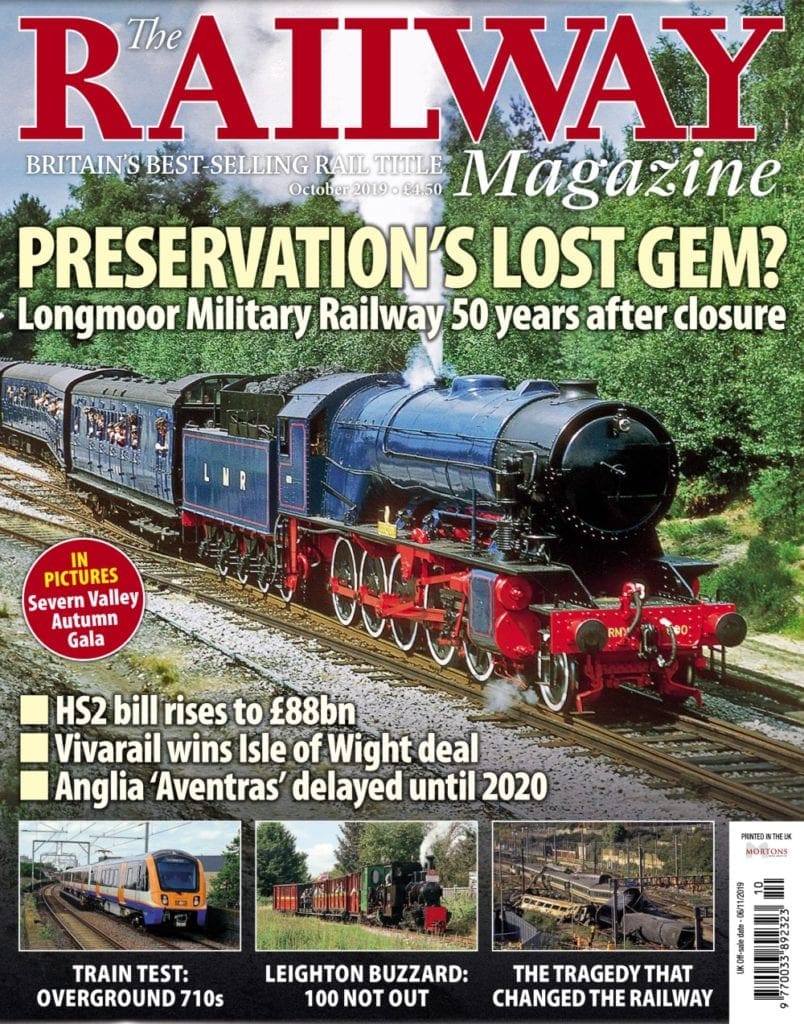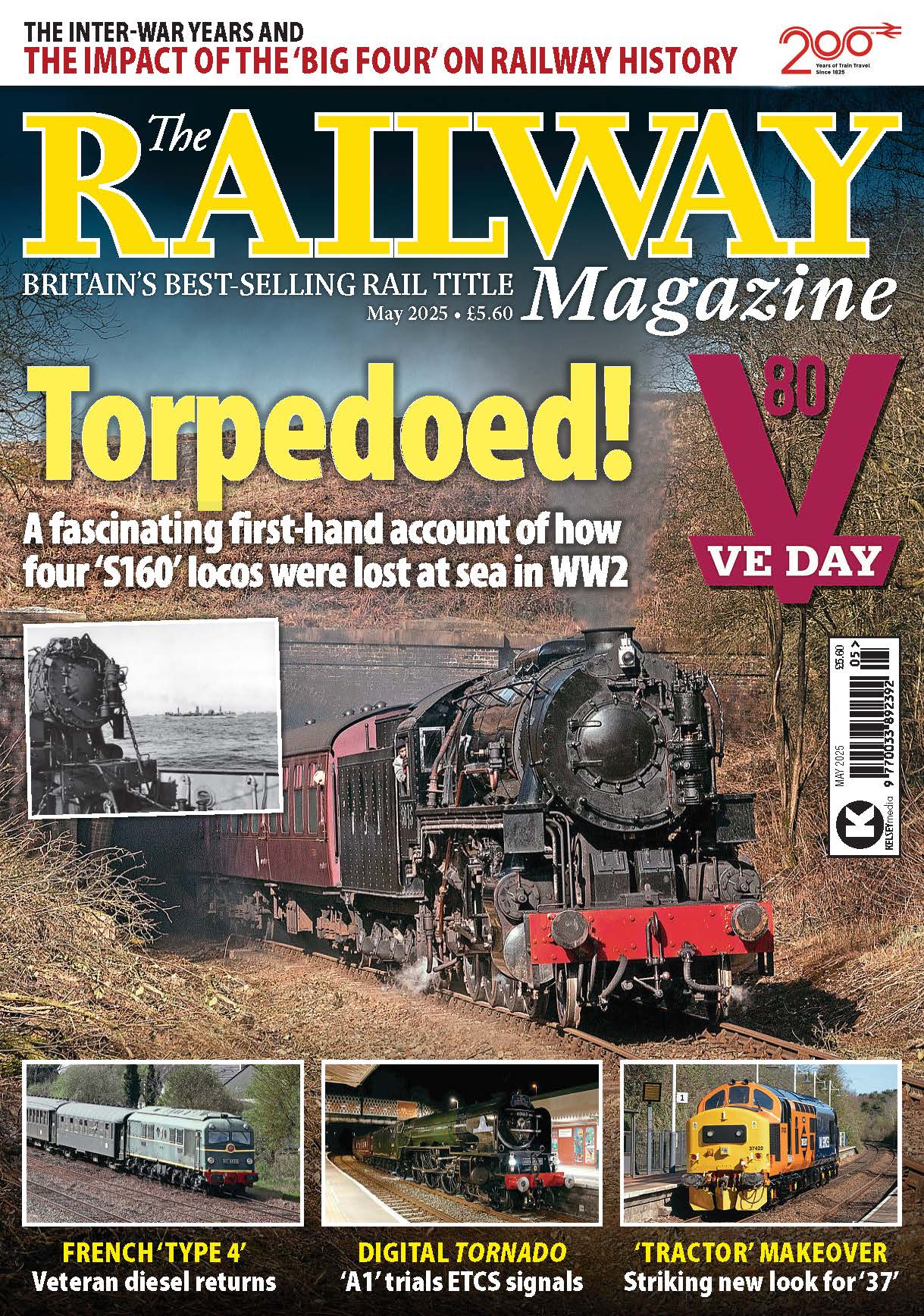Britain’s best-selling rail title is back for another month of award-winning photos, news, features and exclusives from the rail industry, past and present.
This month’s The Railway Magazine features a look back at Longmoor Military Railway with October 31 marking the 50th anniversary of its closure. Gary Boyd-Hope accompanies the feature with a pictorial tribute to one of railway preservation’s lost opportunities.

LAMENTABLE FAILURES | Twenty years on from the crash that killed 31 people at Ladbroke Grove in west London in October 1999, Fraser Pithie looks back at the factors that combined to cause the tragedy, and the changes made as a result.
Monthly Subscription: Enjoy more Railway Magazine reading each month with free delivery to you door, and access to over 100 years in the archive, all for just £5.35 per month.
Click here to subscribe & save
WORKING AT WORTLEY – 1952 | In an unorthodox Practice & Performance feature, John Heaton recalls how the the busy Wortley Junction ’box in Leeds was operated, as well as timings of workings on the routes it served.
TRAIN TEST: LONDON OVERGROUND CLASS 710 | Ben Jones heads to the revitalised Gospel Oak-Barking line in London to try out the first Bombardier ‘Aventra’ EMUs to enter passenger service.
NEWCASTLE CENTRAL | Newcastle’s wonderful listed station has an impressive past but, as Graeme Pickering discovers, it also has a major role to play in the future as the city’s primary transport hub.
PLUS | The Railway Magazine’s monthly news digest covering industrial, steam, Irish, narrow gauge, metro, network, freight and more! Discover some of our readers’ tales in the Reader’s Platform, and make a date for upcoming events in your railway calendar!
Be sure to explore our website too for the latest news updates, teasers, and find out how you can get involved! Just visit: www.therailwaymagazine.co.uk
Subscribers to The Railway Magazine can enjoy unlimited access to the publication’s digital archive from as little as £2 per month.
Get unlimited access to The Railway Magazine digital archive online, on your computer, tablet and smart phone. With more than 100 years’ worth of back issues available, newly digitised editions are added regularly. The collection is fully searchable, you can click to zoom and turn pages and images are all high-resolution where available.

Island Line’s winners and losers
News the Isle of Wight is to get a £26million investment in its rail network is very welcome – even if it has been a long time coming.
The investment will feature Vivarail ‘D Trains’, and assurance has been given they will fit through Ryde Tunnel!
Planned infrastructure improvements means the line will eventually have a balanced 30-minute service, with the retention of the third rail, permitting the new trains to provide a substantial improvement over their 80-year-old counterparts now definitely on their last legs.
Having ridden the ‘D Train’ several times elsewhere, it’s hard to believe they date from 1978, and the reworking of Vivarail’s creation, together with its versatile traction options, along with the numerous interior design options, is a remarkable piece of vision and innovation.
Local passengers are expected to embrace the new trains, with their new facilities, spacious interiors and ease of boarding.
What is very disappointing was the announcement – just 48 hours after the Vivarail news – the Isle of Wight Steam Railway has been forced to throw its plan for trains to Ryde St John’s Road into the long grass until, it says, at least the end of the current franchise in 2024.
It’s a decision that is not good for the railway, nor for the tourism crucial to the island .
To run the distance of one mile, regulatory considerations, infrastructure costs, coupled with an onerous demand to work trains in top-and-tail mode, makes the proposal simply unsustainable, according to the heritage line.
Considering the NYMR can manage to run its seasonal trains six miles over Network Rail metals, let’s hope the parties can get around the table and salvage what is in essence a great plan, along with some realistic cost aspirations.
The cost of The Railway Magazine
It is with regret the cost of The RM has risen by 10p from this issue. The rise is the first since November 2016 and is entirely due to the rising cost of paper, which until now publishers Mortons has absorbed.
With 132 pages in each issue, The Railway Magazine still represents great all round value – even more so if you take out a subscription (see p60).
Time for Britain to get serious about tackling emissions
When the French opened the LGV Est high-speed line in 2007, it led to a substantial cut in flights between Paris and Strasbourg.
Next year, KLM will replace a Brussels to Amsterdam flight with a high-speed train. It could lead to other short journeys being switched to rail, too.
The journey time for rail is double what it is for a flight, but KLM’s decision is a great step for rail and cutting carbon emissions, and passengers won’t have to face the check-in and security rigmarole on top of a journey to the airport, with its rip-off parking charges.
What’s more, travellers are beginning to look at their own carbon footprints, with many not only switching to rail, but liking the relaxation, too.
While HS2 will always have its critics, in time rail could very well replace several daily flights between Manchester, Newcastle, Glasgow and Edinburgh to London, which leave a massive carbon footprint.
Germany is investing
heavily in additional
electric-powered ICE trains over the next three years, and encouraging rail use
by cutting VAT on fares.
But is anything happening in Britain?
If this Government (and indeed the next) is really serious about cutting emissions, what the UK rail network needs – as matter of priority – is a programme of rolling electrification to begin before the end of the decade. The annual fare increase needs reviewing: is it a benefit or hindrance to furthering rail travel?
But above all, everyone needs to see that Britain is serious about reducing greenhouse gas emissions, and is starting to knock these ridiculous long-distance workings of diesel trains under electric wires on the head.




